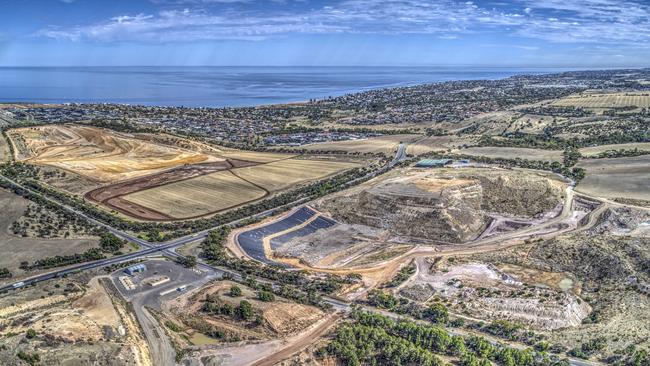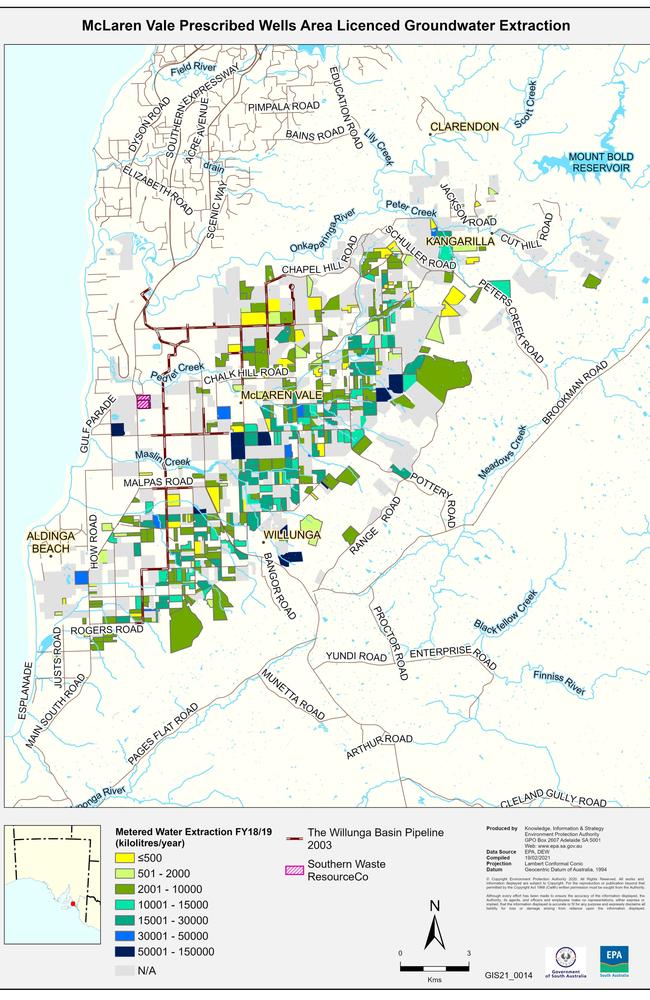McLaren Vale PFAS landfill site awaits EPA approval as Flinders University research examines worst-case groundwater scenario
A controversial plan to send PFAS-contaminated waste to landfill at McLaren Vale is edging closer to reality, as Flinders Uni research seeks to reassure critics.
SA News
Don't miss out on the headlines from SA News. Followed categories will be added to My News.
The Environment Protection Authority is expected to decide on a controversial licence for the state’s first PFAS landfill site, on the edge of the McLaren Vale wine and food region, “within weeks”.
Southern Waste RescourceCo (SWR) last year applied to the EPA to be able to store PFAS-contaminated waste in a landfill “cell” at its Southern Waste Depot site, on Tatachilla Road.
EPA chief executive Tony Circelli said he felt the board now had all the information required to make a decision, and would be “in a position to make a call on that very soon”.
That information included Flinders University research on the “worst-case scenario” for a “catastrophic failure” of the double liner beneath the landfill cell, and movement of the persistent pollutant into groundwater and offsite.
The EPA commissioned the research in response to community concern raised at a public meeting.
However, the next public meeting will only be held after the decision on the licence is made.
“We’ve heard all the issues and we’ve documented all the issues, part of the assessment has to take into account the submissions received from the community,,” Mr Circelli said.
“It has been a very sensitive issue, we certainly empathise and acknowledge that. These aren’t easy issues and I know that the local community’s quite concerned about it.”

The group of chemicals known as PFAS – per-fluoroalkyl and poly-fluoroalkyl substances – is an emerging contaminant with unknown health effects.
PFAS was most famously used in firefighting foams and non-stick cookware.
As Mr Circelli explains, it’s classified as a problematic hazardous waste on the basis of three criteria: persistent, bioaccumulative and then, toxicity.
Currently, contaminated waste is stored on site, with nowhere else to go in SA. But some states have landfill sites.
The existing Southern Waste Depot landfill site, managed by Southern Waste ResourceCo, has applied to also accept PFAS and has built a new landfill “cell” with a double composite liner.
At Flinders University, scientists at the National Centre for Groundwater Research and Training were engaged to examine the potential for offsite contamination in the event of a catastrophic failure of both engineering and regulatory measures.
The report released on Monday afternoon says it is “extremely difficult” to predict groundwater transport because flow direction varies across the site. If PFAS leaked from the landfill it would be likely to enter the groundwater. But that PFAS would reach the sea if the leak was not detected for five years and if it went undetected for longer, it still would not travel so far east as to impact the vineyards in the region.

Mawson state Labor MP Leon Bignell has campaigned vigorously against what he believes will be “one of the biggest acts of environmental vandalism that this state has ever seen”.
“The problem with the EPA is they’ve already made up their mind and now they’re just going to find people to back up their point of view,” Mr Bignell said.
“Nothing is worth sacrificing the beautiful region of McLaren Vale and Aldinga and Maslin Beach and Willunga for the sake of dumping this poison from all around Australia.”
In October Mr Bignell attempted to block the development with the Environment Substances Amendment Bill 2020 put to the Lower House.
The legislation would ban the dumping of PFAS material in the greater Adelaide area, within 50km of primary production land and within 5km of any South Australian township.
The Bill was rejected, but Mr Bignell now plans to put it to the Upper House instead, with the hope of then making a comeback.
McLaren Vale Irrigators Council chairman Jock Harvey, of Chalk Hill, was concerned the storage of PFAS-contaminated material on the doorstep of the wine region could harm its reputation, because “it’s the perception, the science doesn’t matter”.
“Importing contaminated soil containing this chemical could be detrimental to the environment but more so to the perception of the region, in the eyes of the consumer,” Mr Harvey said.
“While this particular development already has toxic chemicals put into the dump, it is the making of this compound (PFAS) into a political issue that can be detrimental to the promotion of a food production area as well.
“So while I don’t support dumping of a chemical in this region, because of its food production and its underground water resource, I recognise that the chemical is widespread in the environment and it could be taken to another facility, one that is not involved in food production and does not have an underground water source.”
Concerned Port Willunga resident and business owner Emily Dinnen Inglis said PFAS storage would present “serious health issues for producers and community if it were to leach into any of these major aquifers”.
“The risk to tourism, community and business is extreme,” Ms Inglis said.
SWR has previously said the Tatachilla Road facility’s technology provides a superior level of security and safeguards the environment and, importantly, prevents any contamination of groundwater.





